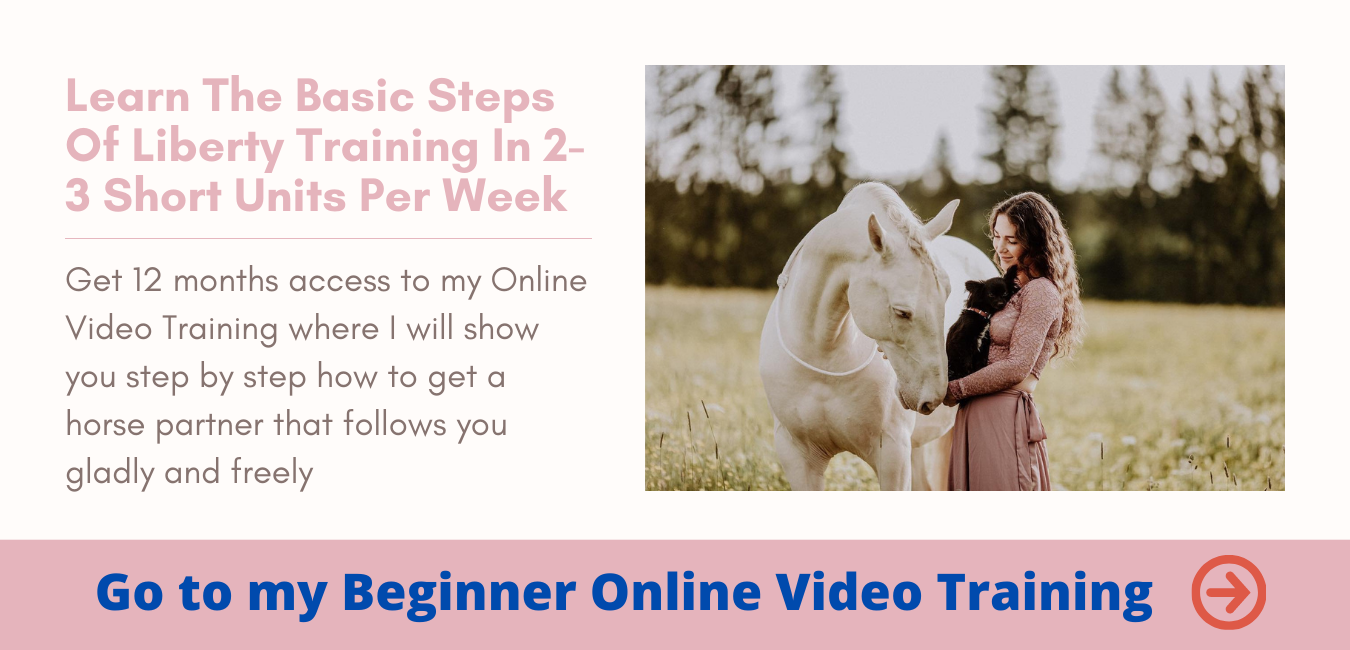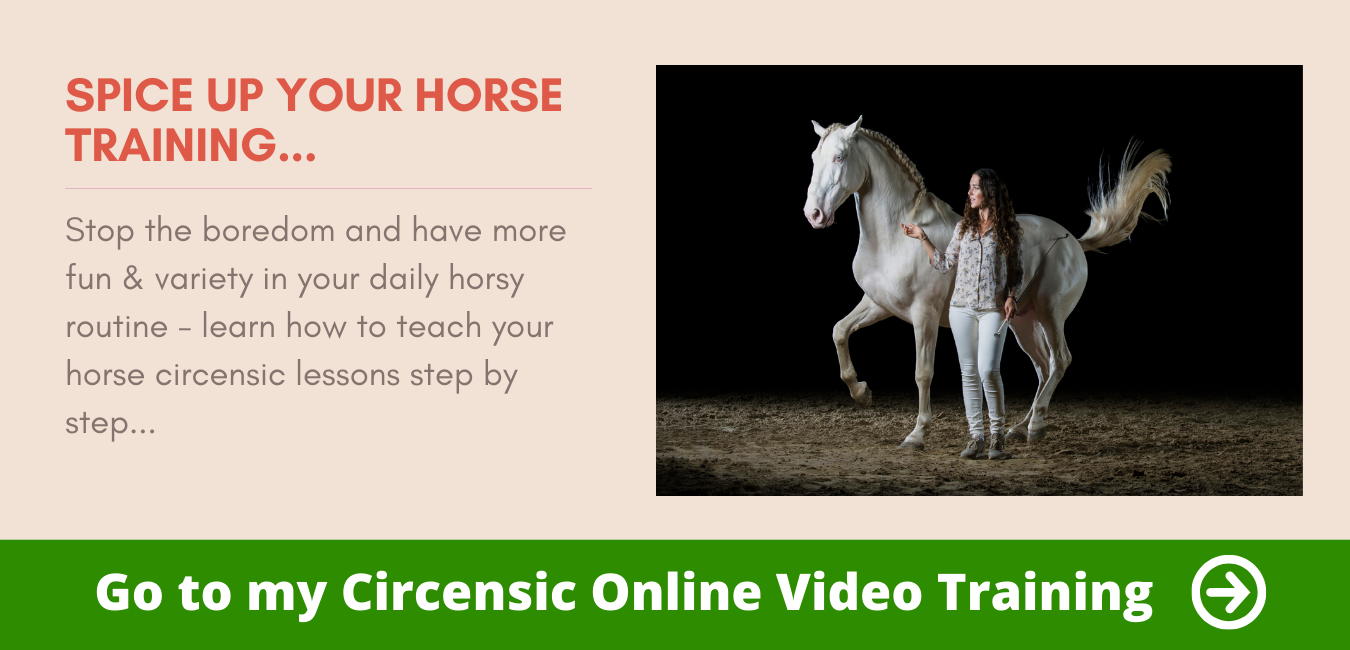Today I would like to talk about a topic that comes up again and again in my courses:
The more dominant horses.
Because they might lead to a point, where your horse training is becoming dangerous – and as a horse owner you never know when “the volcano is really going to explode”.
On the other hand, I also see horse owners who are not aware of “the danger” at all.
And it seems to be only a matter of time until they are bumped, kicked or even bitten for the first time.
What is a dominant horse?
But first of all, let’s take a look at what a dominant horse is.
Because dominance itself is not a bad thing at first. “Being dominant” only means to be sure of your cause – and to assert yourself.
Therefore, in the beginning this has absolutely nothing to do with aggression! And it does not have to lead to an aggressive action.
Because anyone who has ever observed a harmonious herd of horses will have with no doubt realised that one ear of the higher-ranking horse that had been folded back briefly was enough to let another horse give way – without any physical contact or bleached teeth.
So dominance is basically nothing bad – it only becomes dangerous for us humans if we cannot handle it.
Or even worse: not even notice it.
My experience with Atila
I also had to make this experience once before.
A few years ago I had a visit from a photographer. I was very excited and wanted to show him Atila’s skills from the best side.
So from the very beginning my attention was not on my horse, instead on the camera, the perfect pose and the most beautiful light.
When it came to climbing I hardly concentrated on my sensitive stallion.
I let him climb several times, but the photographer asked me for one last shot. I had a strange feeling in my stomach, but said nothing and ignored my feeling.
I let Atila climb almost without looking at him – and out of an aggressive rebellion he shot forward at lightning speed, bit my shoulder and lifted me up.
At this point I was more than perplexed and disappointed by what had caused my horse to make this attack – because nobody had seen it coming.
But today I know that I overlooked the many fine signals my horse was sending.
Simply because I was too distracted to look and listen.
And I only understood that much later!
The ringing of the alarm bells
But when should you now start “correcting” your horse? Preferably as early as possible!
Because then it won’t even get that far.
Horses usually have much finer sensors than we do – and therefore often try to expand their limits millimeter by millimeter.
The earlier we recognise this, the more confidently we can react. And the safer our horse feels with us.
Because dominance is rarely a demonstration of the horse’s power.
The trigger is usually that our horse gets the feeling that we are not up to the situation – and that it has to take the lead and make decisions itself.
The more security we give our horse through a confident and consistent appearance, a clear and certain body language and fixed rules, the better he can relax – and the faster “dominance issues” will no longer be an issue!
So the most important rule is: Stick to your rules!
What is “no” today is a “no” tomorrow, and what is allowed today will still be allowed tomorrow.
Consequence is the A & O – even if it is sometimes difficult
Recognizing fine signals – and interpreting them correctly
In the end, the art lies in noticing very fine signals from the horse’s side towards “taking over power” – and to correct them gently but firmly.
This begins, for example, with the horse getting more and more on your shoulder when you lead it.
In the initial stage, it doesn’t even have to touch you – it simply looks to see if you move millimeter by millimeter.
Some horses have perfected this tactic and “push” their human – not even noticed by him – away from them.
Since with horses the question is always “Who is moving whom?”, this alone is a sufficient signal that the human is not sure of his business.
Of course, there are also characters among the horses who do not take everything so precisely.
Then you are in demand, so to speak: To know how consistent you have to be with your horse – and how “alert” you insist that your limits are respected.
[su_youtube url=”https://youtu.be/yMJtcMyUGwg”]
The most important thing is probably that the person belonging to it is sure of his or her cause and has a corresponding – and above all, acknowledged by the horse! – leadership and confidence.
That’s why I will then briefly discuss how you should react if your horse is dominant and gets too close to you, for example when you are circling.
Dominant horses are basically great teachers from whom we can learn a lot about ourselves.
Like me from Atila. He has definitely shaped my way with the horses! And yet they are also a warning never to handle these big animals too lightly – and to constantly learn to really know what we are doing.
It’s really no shame to get a trainer to help you when you don’t know what to do.
It is even reasonable! If your horse is really dominant, I can advise you to take this step sooner rather than later.
Because it is easier – and above all fairer to the horse! – to “nip dominant behaviour towards humans in the bud” than to let the horse learn that it is physically superior to humans.
In any case, I wish you a lot of joy in liberty dressage – whether with or without a dominant horse!
It is never wrong to always watch your horse very closely and above all to constantly reflect on whether we are still sending the right signals – mentally and in terms of body language! – send out.
And of course to correct ourselves in case of doubt.
“Wrong behaviour” is never primarily due to the horse, but always to the person.
At least for me it is true: In case of doubt for the accused
All love
Your Kenzie




